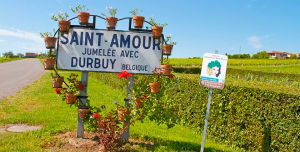BLOG
Beaujolais
Kids in France grow up reading about the adventures of Asterix the Gaul.
If there’s one thing in the world I love, it’s judging. From driving, to elite sport, to other people’s parenting, if you’re looking for someone to cast ill-informed opinions out into the wind, I’m your man. So, when the opportunity arose to contribute to what is probably the world’s greatest wine judging competition, I signed myself up quicker than you can say ‘baby-lead weaning’. Thankfully this is one area where I’m at least a little more qualified to apply
Synopsis:
Masterclass delving into what is new in terroir-focused Beaujolais, covering the region's recent soil mapping project, stylistic evolutions in the 10 crus and beyond, trends from the latest generation of winemakers, latest in sustainable winemaking and climate change adaptation, and more.
About the Speaker:
Jacky Blisson MW is an independent wine educator, video presenter, writer, and consultant with over two decades experience in all facets of the
WSG is proud be the first Educational Partner of The Old Vine Conference. Read more to find out how this dynamic non-profit organization is actively creating a global network of old-vine disciples while raising awareness through education.
The economic and social relevance of old vines is real, but the structure of the global wine industry stacks the odds against the regenerative commercial viability of old vines. The result is that healthy old vineyards of cultural resonance and unique qualitative potential are lost because they can’t be made to pay.
The Old Vine Conference is a non-profit organisation whose aim is to bring together a global network to create a new category for wine from heritage vineyards. The Old Vine Conference works to safeguard old vines of cultural and ecological value by connecting, educating and inspiring the global wine industry through conferences, research, partnerships, tastings and fieldtrips.
On the surface, promoting Beaujolais’s best vineyards to premiers crus might appear entirely beneficial for the region. But the situation is more complex than it looks, says Beaujolais expert Natasha Hughes MW.
Over the past 20 years, the restoration of Beaujolais has been one of the great success stories in French wine. For decades it was best known for simple Beaujolais Nouveau, rushed out for consumption on the third Thursday of November every year, but the hullaballoo around this marketing stunt is now dissipating as the potential quality of its cru wines draws the spotlight.
The best way to make sense of French red wines is to simply start tasting them. France offers the perfect red wine for every occasion—from steak frites on Monday, to boeuf bourguignon with the in-laws on Sunday.
Many of France’s best red wines are labeled with the name of the wine appellation, rarely by grape variety.
If you’ve ever felt completely overwhelmed while browsing a French wine section, knowing just a few key wine names will help keep your shopping trip focused and ensure that you have the perfect wine to drink at a moment’s notice.
It is almost here. That wonderful day in March that wine lovers all over the world anxiously wait for every year. Thousands gather for jubilant festivities of the wines of Beaujolais. No, my calendar does not need adjusting. November’s annual harvest fete known as Beaujolais Nouveau Day is a distant memory by the time the real stars of this French wine region are allowed to be released to adoring fans. Though you would be correct if you said I was overstating the excitement of the annual release of the crus of Beaujolais (and in actuality most are aged longer than laws dictate), these are wines worth celebrating.
The Crus of Beaujolais are stand-alone AOCs representing the region’s very best vineyard land. These are high-quality wines reflecting individual terroirs and showcasing the great potential of the Gamay grape. Gamay is one the most underrated red grapes and the Crus of Beaujolais provide an incredible value to quality ratio.
There are ten Beaujolais Crus, each named for a village within the growing area. Following in succession, the Crus span approximately 20km/12.5mi of northern Beaujolais. The soils in this part of the region are largely what makes these places so special. Primarily a mixture of ancient granite and schist, the soils of the Cru areas bring out the best in Gamay. Across the board, these are structured, complex wines with spicy aromas and the potential to age well, but each Cru has its distinctive signature. The following excerpts from our French Wine Scholar® manual describe what makes each Cru special.








